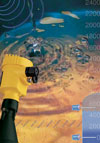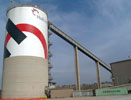

The countrywide construction boom has meant that suppliers of cement products have had to step up production with some even moving to a continuous 24/7 production schedule. This increased level of demand has in turn meant that cement suppliers are demanding an improved level of service and support to meet these insatiable production targets.
The countrywide construction boom has meant that suppliers of cement products have had to step up production with some even moving to a continuous 24/7 production schedule. This increased level of demand has in turn meant that cement suppliers are demanding an improved level of service and support to meet these insatiable production targets.
At Holcim Cement's Roodepoort operation, level control in silos and hoppers is critical to maintaining optimum productivity. Vega sensors have been installed at several points in the plant and are proving more than capable of performing under these arduous conditions. The four principal ingredients that are used to produce cement are gypsum, clinker, fly ash and slag, all of which may potentially create an excessive amount of dust in the atmosphere if not treated properly.

Fired, or burnt clinker is delivered to the plant by rail car, and is conveyed from the off-loading point to the top of a 30-metre storage silo. Here a Vegason ultrasonic sensor was installed in 2002 for continuous level measurement and later Vegavib vibration level switches with 3 metre suspension cables, for overfill protection. The version of vibration level switch chosen comes with a single rod as this prevents build-up, which can cause problems for the traditional tuning fork switches.
The clinker is then discharged from the bottom of the storage silo onto another conveyor belt, where it is carried up to three large enclosed hoppers and tipped through a small opening. Inside each opening is a Vegapuls 68, Vega's non-contact radar sensor that is unaffected by dust and noise from falling material and surrounding activities. Fly ash is also conveyed up to three adjacent open hoppers, and again the Vegapuls 68 with its 70-metre measuring range is providing reliable and accurate control. The Vegavib level switches for overfill protection have also been installed here, replacing some old mechanical probes.
"We were able to install the Vegapuls 68 non-contact radars on a trial basis," said Trevor Bryant, Holcim Cement's chief instrument technician, "as Vega Instruments SA was confident enough to guarantee the performance of its instruments for our applications.
"We were impressed with the instrument's performance levels and it has been specified throughout the plant where appropriate," he continued.
From the hoppers the clinker is then conveyed, together with the fly ash, into one of the three milling drums where it is crushed and mixed. A Vegadif differential pressure transmitter is installed at each end of the milling drums to prevent overfill and potential blockages. Attached to each mill is a large bag filter, which filters the dust generated from the mills. A differential pressure transmitter is also installed here, to control the free flow of air being sucked through the filter.
Once crushed and mixed, the cement powder is stored in a series of 12 silos at the bulk loading site. These silos vary in height between 16 metres and 18 metres. To control the level of cement product going into these silos, Vegaflex 62 guided microwave sensors have been installed. These sensors, which have replaced an electromechanical system, are ideal as they are reliable during the pneumatically conveyed filling process.
Finally, there is a bank of eight blending silos, where special mixes are blended according to customers' demands. The Vegapuls 68 non-contact radar sensor has again been selected to control level, due to its versatility in measuring at length. The Vegavib 61 has been installed for point level, or overfill control.
"We are very pleased with the level of service and application engineering that we receive from Vega Instruments SA," stated Bryant. "These guys are always willing to come out and help us with any problems that might occur, day or night."
He continues: "I am also very impressed with the functionality and ease of calibration of the radar sensors that we have installed all over the plant."
For more information contact John Groom, Vega Instruments SA, +27 (0)11 958 1901, [email protected], www.vega.com
| Tel: | +27 11 795 3249 |
| Email: | [email protected] |
| www: | www.vega.com/en/home_za |
| Articles: | More information and articles about VEGA Controls SA |

© Technews Publishing (Pty) Ltd | All Rights Reserved